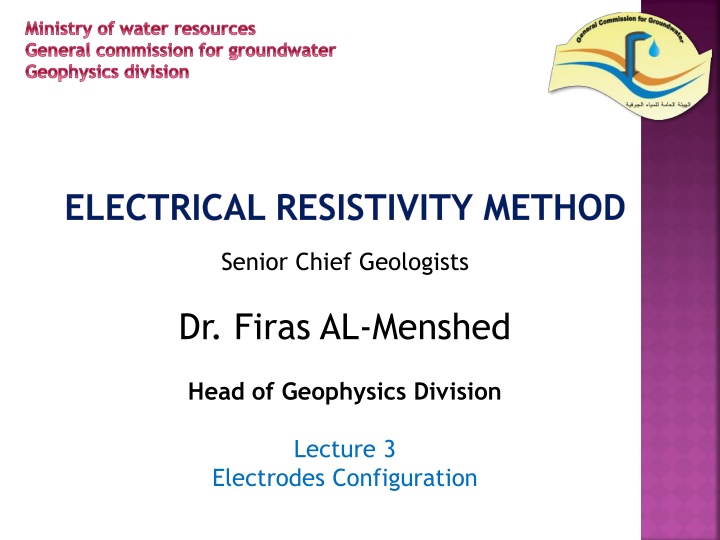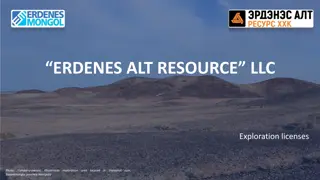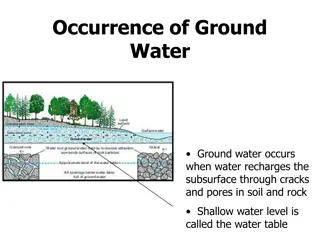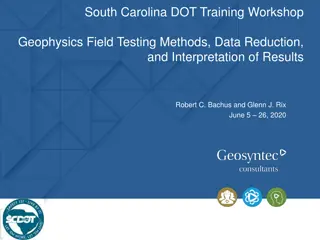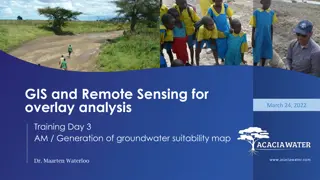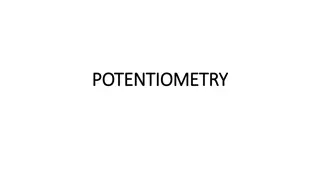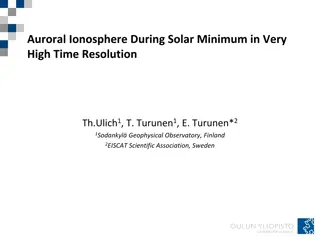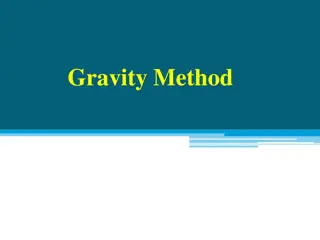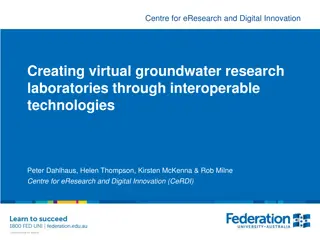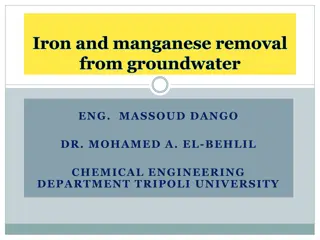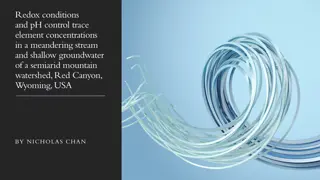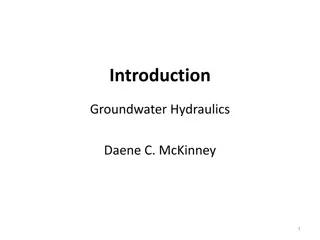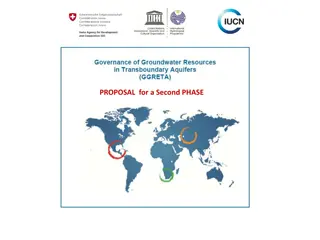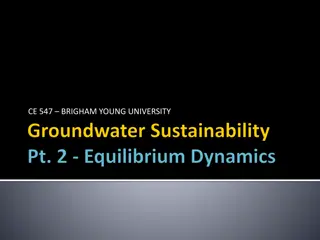Geophysical Methods for Groundwater Exploration: Electrodes Configuration and Array Types
The lecture discusses the utilization of electrical resistivity methods in geologic investigations, focusing on electrode configurations such as symmetrical linear and non-linear arrays. Detailed insights are provided on the Wenner and Schlumberger arrays, including their properties and depth of investigation capabilities, essential for effective groundwater exploration.
Download Presentation

Please find below an Image/Link to download the presentation.
The content on the website is provided AS IS for your information and personal use only. It may not be sold, licensed, or shared on other websites without obtaining consent from the author.If you encounter any issues during the download, it is possible that the publisher has removed the file from their server.
You are allowed to download the files provided on this website for personal or commercial use, subject to the condition that they are used lawfully. All files are the property of their respective owners.
The content on the website is provided AS IS for your information and personal use only. It may not be sold, licensed, or shared on other websites without obtaining consent from the author.
E N D
Presentation Transcript
Ministry of water resources General commission for groundwater Geophysics division ELECTRICAL RESISTIVITY METHOD Senior Chief Geologists Dr. Firas AL-Menshed Head of Geophysics Division Lecture 3 Electrodes Configuration
Electrodes configuration There are numerous configurations or arrangements for placing the current and potential electrodes for surveying. The most appropriate for geologic investigations is shown as below. Symmetrical Linear Non- symmetrical Electrodes array Non-linear
Wenner array This array was developed by Frank Wenner in the U.S. at about the same time that Schlumberger developed his techniques in France. Wenner worked in the national standards laboratory on material properties, and realized that he could apply the same four point method used in the laboratory in the field to measure bulk Earth resistivity. Consequently, the array that bears his name has equal spacing between all electrodes. AM=MN=NB A M N B a a a
Wenner array A M N B a a a For Wenner array, apparent resistivity measured by the equation: V = 2 a a I
Properties of Wenner array 1. In general, the Wenner is good in resolving vertical changes (i.e. horizontal structures). 2. Relatively poor in detecting horizontal changes (i.e. narrow vertical structures). 3. The median depth of investigation for the Wenner Alpha array is approximately 0.5 times the a spacing used. Compared to other arrays, the Wenner array has a moderate depth of investigation. 4. The signal strength is inversely proportional to the geometric factor used to calculate the apparent resistivity value for the array. 5. The geometric factor for the Wenner array is 2 a. This is smaller than the geometric factor for other arrays. 6. Among the common arrays, the Wenner array has the strongest signal strength. This can be an important factor if the survey is carried in areas with high background noise.
Schlumberger array It is the most commonly used arrangement, and was developed by Conrad Schlumberger. Like most of the standard arrays it is collinear and symmetrical. The particular feature of the Schlumberger array is that the potential electrode spacing (MN) is very much smaller (about 1/5 to 1/6) than the current electrode spacing (AB). AM=BN>>MN A M N B
Schlumberger array A M N B a To compute the expression for apparent resistivity for + = ] 1 [ this array: V n n a a I AM a = n = MN MN
Properties Schlumberger array 1. Schlumberger array is moderately sensitive to both horizontal (for low "n" values) and vertical structures (for high "n" values). 2. In areas where both types of geological structures are expected, this array might be a good compromise between the Wenner and the dipole-dipole array. 3. The median depth of investigation for this array is about 10% larger than that for the Wenner array for the same distance between the outer (A and B) electrodes for "n" values greater than 3. 4. The signal strength for this array is approximately inversely proportional to the square of the "n" value. 5. The signal strength is weaker than that for the Wenner array, but it is higher than the dipole-dipole array and twice that of the pole-dipole. of
Dipole-dipole array These arrays are originally developed in the Soviet Union in the 1950s; they have certain advantages over the Schlumberger array for deep soundings because relatively short AB and MN lines reduce field measurement times. In addition, fewer problems are associated with current leakage and inductive coupling than for Schlumberger soundings. The linear kind of dipole-dipole group which is the polar or axial dipole-dipole array as illustrated below: AB=MN<BN M A B N a a n
Dipole-dipole array M A B N a a n Apparent resistivity for Dipole-dipole array measured by the equation: V = + + [ 1 ][ ] 2 n n n a a I
Properties of Dipole-dipole array 1. The dipole-dipole array is very sensitive to horizontal changes in resistivity, but relatively insensitive to vertical changes in the resistivity. Thus it is good in mapping vertical structures, such as dykes and cavities, but relatively poor in mapping horizontal structures such as sills or sedimentary layers. 2. The median depth of investigation of this array depends on both the a spacing and the n factor. 3. In general, this array has a shallower depth of investigation compared to the Wenner array. 4. The median depth underestimate the depth of structures sensed by this array by about 20% to 30% for the large n factors. 5. One possible disadvantage of this array is the very low signal strength for large values of the n factor. of investigation might
